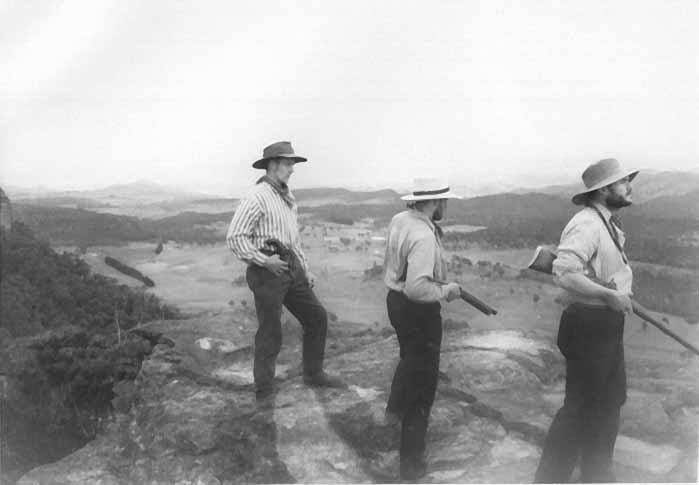POST WORLD WAR TWO: RE-ENACTMENTS AND SCULPTURES
Public reverence for Blaxland, Lawson & Wentworth did not abate with the birth of the nuclear age, though it did seem to express itself somewhat differently.
During the 50th Anniversary of Federation in 1951 the three explorers made an, almost literal, appearance in the service of national and local pride. Their memorial that year took the form of a re-enactment of their crossing of the Mountains with the members of a number of bushwalking groups chosen to play the role of the three explorers and their four servants. As their rigorously choreographed two-week (16-28 May) progress to Mount York proceeded they participated in a variety of local festivities in the various towns along the way.

[Re-enactment, May 1951. Blaxland, Lawson & Wentworth at Mount York. ]
To enhance the drama of the event, history was subjected to a good deal of poetic license. At Woodford the explorers were confronted by a group of local 'Aborigines' (scouts and cubs) who forced them to eat sausage snakes and witchetty grubs made of icing sugar. While, earlier, at a Jubilee Ball held in Glenbrook, the relationship between time and space underwent further distortion when the presence of the exploration party was momentarily forgotten as the guests were bailed up by the Kelly Gang.
The explorers were also escorted onto the newly established RAAF Base at Lapstone where Air Vice-Marshall McCauley congratulated them on subduing “this wild land” and informed them, with a suitable touch of Cold War paranoia, that “it is up to us to see that it is not taken from us”. (Blue Mountains Advertiser 24 May 1951.)
When the party finally reached Katoomba thousands of spectators lined Katoomba Street to watch the 'expedition' march triumphantly through the premier Mountain town.
This stirring and dramatic street theatre was so successful in 1951 that it was repeated for the expedition's sesquicentenary in 1963. Again, bushwalkers played the main roles and a two-week march allowed a programme of events to include all the Mountain centres. Once more, history was subjected to the dramatic flourishes of poetic license, most notably (and ironically) when the party arrived at the Explorers' Tree and were subjected to an 'attack' by local 'Aborigines'. No sharing of culinary cultures this time!!

[Re-enactment, May 1951. Blaxland, Lawson & Wentworth arrive in Katoomba.]
In 1959 a Sydney publisher, Oswald Ziegler, canvassed support in the Mountains for a plan to memorialise the three explorers on a hitherto unheard of scale. As part of a proposed luxury hotel and resort to be built on the cliffs above the Grose Valley at Blackheath, he proposed that a huge rock tableau featuring relief figures of the explorers be carved by a team of Australia's best sculptors into the cliff face opposite Govett's Leap. “Using pneumatic drills and gelignite charges”, he said, “sculptors and workmen would work on platforms hung hundreds of feet above the Grose Valley.” His grand vision was of an Australian 'Mount Rushmore', an inscription of the landscape in recognition of a process, begun by BW&L, of colonising a mountain wilderness once thought impregnable.
This extraordinary proposal apparently received the support of Hal Missingham, Director of the Art Gallery of NSW, and leading Australian sculptor Lyndon Dadswell. The Mayor of the Blue Mountains, Alderman Aubrey Murphy, enthusiastically gave his support too, claiming that the scheme “would lure thousands more tourists to the Blue Mountains”. (Sunday Telegraph 17 May 1959.) Neither the resort nor the memorial ever got off the ground!
In the late1960s a sculpture project of much more modest proportions was in fact carried out, not at Blackheath but among the other memorials on the hallowed ground of Mount York. It was a work of private rather than public initiative. Constructed over several years by Rex Gilroy and his father, William, managers of the Mount York Natural History Museum, the monument consisted of the busts of the three explorers placed on top of a solid, slightly curved base. The busts were the work of sculptor Josef Nesteriuk and the completed monument was unveiled by H. G. Coates, State Member for the Blue Mountains, on 14 December 1969. In recent years the memorial has fallen victim to vandals who knocked one of the heads off and left it in the bush some distance away. The Council has removed the other two for safekeeping.
 |
© John Low 2001
